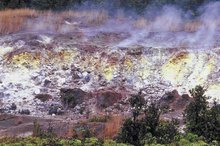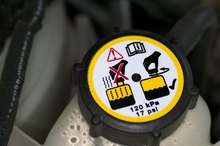Uses of Phenyl Benzoate
The Facts
Phenyl benzoate is defined by the chemical formula C13 H10 O2. It has a molecular weight of 198.2212, a boiling point of 298 to 299 degrees Celsius and melting point of 68 to 70 degrees Celsius, according to chemexper.com. At normal room temperatures, the substance appears as a white crystalline powder. Phenyl benzoate also may be referred to as benzoic acid, phenyl ester, Diphenylcarboxylate or phenol benzoate.
- Phenyl benzoate is defined by the chemical formula C13 H10 O2.
Uses
One use that takes advantage of the electrical properties of phenyl benzoate is the development of liquid crystal displays. Phenyl benzoate based liquid crystals have excellent compatibility characteristics with other materials used in liquid crystal displays, such as biphenyl, phenylcyclohexane, bicyclohexane and fluorine types, especially at low temperatures, according to U.S. patent 6468606.
Phenyl benzoate is considered an excellent starting material for the production of optical components, particularly high quality lenses for still and motion picture cameras.
Esters
Esters are a large body of organic compounds that react with water to form alcohols or acids. The ester itself is formed in a reaction between an alcohol and an acid in which water is eliminated. The most common esters are made from carboxylic acid and an alcohol. The alcohol can be replaced in certain circumstances with a glycerol or a phenol to create an ester, of which phenyl benzoate is an example, according to chemguide.co.uk.
- Esters are a large body of organic compounds that react with water to form alcohols or acids.
- The ester itself is formed in a reaction between an alcohol and an acid in which water is eliminated.
Preparation
Phenyl benzoate preparation should take place under a fume hood and certain safety precautions should be taken (safety goggles and gloves), according to alevelchemistry.co.uk 3. The first step is to combine the phenol with sodium chloride in a 2M solution in a conical flask. Then, under the fume hood, add in the benzonyl chloride and insert the stopper into the conical flask and shake for about 15 minutes, periodically relieving the pressure in the flask. After 15 minutes, cool the flask and filter the contents to separate the phenyl benzoate and wash with water to remove the remaining benzonyl chloride.
- Phenyl benzoate preparation should take place under a fume hood and certain safety precautions should be taken (safety goggles and gloves), according to alevelchemistry.co.uk 3.
Applications
According to U.S. patent 4680372 as listed on patentstorm.us, aromatic polyesters--such as phenyl benzoate--have a variety of useful properties, such as high tensile strength, impact resistance, resistance to heat and to UV irradiation, as well as electrical properties. Phenyl benzoate is used primarily as a part of the production of polyesters with a wide variety of applications.
Dangers
While it is generally stable at room temperature, phenyl benzoate does have some harmful properties. According to msds.chem.ox.ac.uk, this compound is harmful and very toxic if swallowed and is also a skin irritant. It is also recommended that the user wear safety goggles to prevent the powder from entering the eyes and to avoid breathing the dust or vapor 3.
Related Articles
References
- Environmental Chemistry
- Chemistry Expert
- Safety Data Sheet
- Benzoic acid and its derivatives as naturally occurring compounds in foods and as additives: Uses, exposure, and controversy - PubMed
- Benzoic acid and its derivatives as naturally occurring compounds in foods and as additives: Uses, exposure, and controversy - PubMed
- Benzene as a Chemical Hazard in Processed Foods
- Re-evaluation of benzoic acid (E 210), sodium benzoate (E 211),
- Sensitivity to food additives, vaso-active amines and salicylates: a review of the evidence
- Re-evaluation of benzoic acid (E 210), sodium benzoate (E 211),
- Re-evaluation of benzoic acid (E 210), sodium benzoate (E 211),
- Re-evaluation of benzoic acid (E 210), sodium benzoate (E 211),
- WHO | JECFA
- WHO | JECFA
- Food Additive Status List | FDA
- Benzene as a Chemical Hazard in Processed Foods
- Re-evaluation of benzoic acid (E 210), sodium benzoate (E 211),
- Sensitivity to food additives, vaso-active amines and salicylates: a review of the evidence
- Benzoic acid and its derivatives as naturally occurring compounds in foods and as additives: Uses, exposure, and controversy - PubMed
- Benzene as a Chemical Hazard in Processed Foods
- Occupational exposure to carcinogens: Benzene, pesticides and fibers
- Artificial Food Colors and Attention-Deficit/Hyperactivity Symptoms: Conclusions to Dye for
- Re-evaluation of benzoic acid (E 210), sodium benzoate (E 211),
- WHO | JECFA
- Re-evaluation of benzoic acid (E 210), sodium benzoate (E 211),
- Re-evaluation of benzoic acid (E 210), sodium benzoate (E 211),
Writer Bio
Kate Prudchenko has been a writer and editor for five years, publishing peer-reviewed articles, essays, and book chapters in a variety of publications including Immersive Environments: Future Trends in Education and Contemporary Literary Review India. She has a BA and MS in Mathematics, MA in English/Writing, and is completing a PhD in Education.







